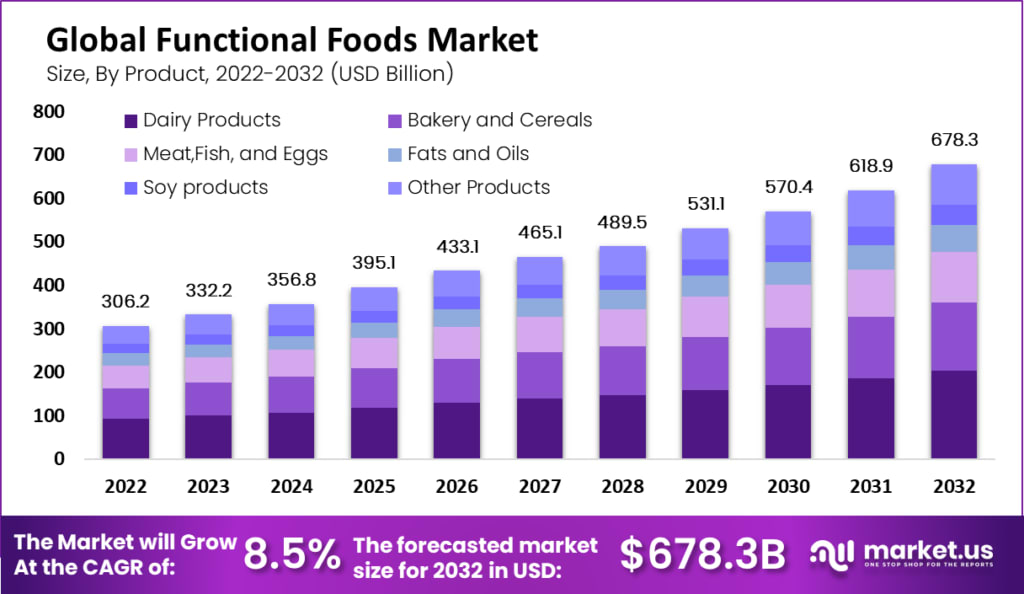Busy Lifestyles Drive Shift Towards Healthier Functional Foods Market
Global Functional Foods Market size is expected to be worth around USD 678.3 Billion by 2032 from USD 306.2 Billion in 2023, growing at a CAGR of 8.5%

Overview
Global Functional Foods Market size is expected to be worth around USD 678.3 Billion by 2032 from USD 306.2 Billion in 2023, growing at a CAGR of 8.5% during the forecast period from 2022 to 2032
The functional foods market refers to a segment of the food industry that focuses on products designed to offer health benefits beyond basic nutrition. These foods contain bioactive compounds such as vitamins, minerals, probiotics, and antioxidants that can enhance overall health, reduce the risk of chronic diseases, and improve specific bodily functions. The demand for functional foods is driven by an increasing awareness of health and wellness among consumers who are looking for natural and effective ways to boost their health.
In this market, products range from fortified foods and dietary supplements to natural foods with inherent health benefits, like fruits, vegetables, and whole grains. Innovations in food technology and nutrition science have expanded the variety of functional foods available, allowing manufacturers to create products that cater to specific health concerns, such as heart health, digestive health, immune support, and cognitive function. This has led to a diversification of products, including beverages, dairy products, snacks, and bakery items.
The functional foods market is characterized by rapid growth and significant investment in research and development. Companies in this sector focus on developing new formulations and delivery methods to maximize the health benefits of their products.
Regulatory frameworks and consumer trust play crucial roles in shaping the market, as the efficacy and safety of functional foods are key concerns. Overall, the functional foods market represents a dynamic intersection of food and health, reflecting broader trends in consumer behavior and advances in nutritional science.
Key Market Segments
Product
Soy products
Bakery & cereals
Meat, fish, & eggs
Dairy Products
Fats & oils
Other Products
Ingredient
Vitamins
Minerals
Dietary Fibers
Carotenoids
Probiotics & prebiotics
Other Ingredients
Application
Sport Nutrition
Digestive Health
Weight Management
Immunity
Clinical Nutrition
Cardio Health
Other Applications
Download a sample report in MINUTES@ https://market.us/report/functional-foods-market/#requestSample
The functional foods market is segmented into various product categories: soy products, dairy products, bakery & cereals, fats & oils, meat, fish, & eggs, and others. Dairy products dominate this segment, accounting for a significant share of global revenue.
Based on ingredients, the market is divided into dietary fibers, minerals, carotenoids, vitamins, probiotics & prebiotics, and others. The vitamin segment leads this category, dominating the global functional foods market.
In terms of application, functional foods are categorized into sports nutrition, weight management, clinical nutrition, digestive health, immunity, cardio health, and others. Cardio health holds the largest market share, driven by the rising demand for functional foods to prevent cardiovascular diseases such as congestive heart failure, congenital heart failure, and hardening of veins.
Top Key Players
BASF SE
Amway Corp.
Herbalife International of America Inc.
The Coca-Cola Company
Cargill Incorporated
GFR Pharma
Cargill Incorporated
Standard Functional Foods Group Inc.
Arla Foods
Nutri Nation
Other Key Players
Driver: The functional foods market is driven by increasing demand for nutrient-rich foods due to busy schedules, hectic lifestyles, and emerging diseases. Rising life expectancy and health awareness have also promoted the use of functional foods, with individuals opting for these over fast food for their health benefits.
Restraint: The development of nutritional contents in functional foods requires significant investment for production. Producing proper nutrients demands substantial financial resources and specific conditions, making it a costly endeavor for manufacturers.
Opportunity: The preference for natural carotenoids over synthetic ones due to purity and lower contamination risks presents a significant opportunity. The growing trend of incorporating functional nutrients like omega-3 and probiotics in products such as yogurt and fish oils to enhance intestinal microflora and reduce cardiovascular disease risks is expected to propel market growth.
Challenge: The primary challenge in the functional foods market is the high cost and complexity of nutrient production. Ensuring the quality and efficacy of these nutrients requires meticulous processes and stringent conditions, posing a significant hurdle for manufacturers.
About the Creator
Enjoyed the story? Support the Creator.
Subscribe for free to receive all their stories in your feed. You could also pledge your support or give them a one-off tip, letting them know you appreciate their work.





Comments
There are no comments for this story
Be the first to respond and start the conversation.